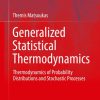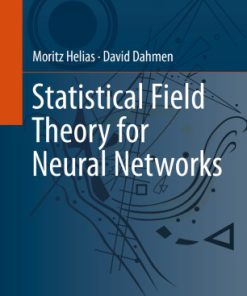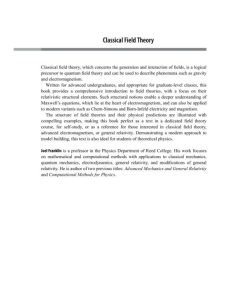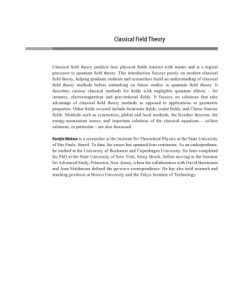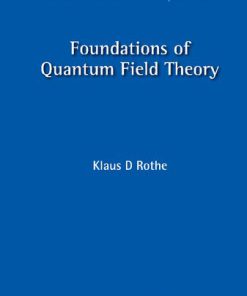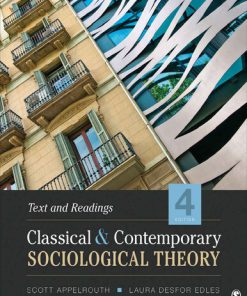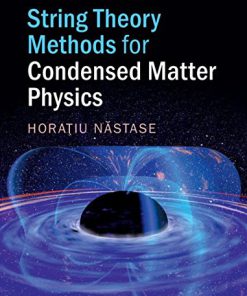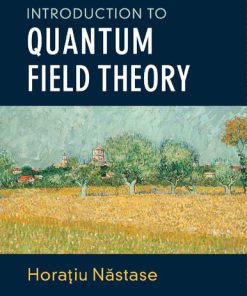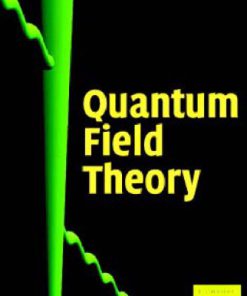Classical Field Theory 1 Hardcover 1st by Horatiu Nastase 1108753213 9781108477017
$50.00 Original price was: $50.00.$25.00Current price is: $25.00.
Classical Field Theory 1 Hardcover Edition Horatiu Nastase – Ebook Instant Download/Delivery ISBN:1108753213, 9781108477017

Product details:
Table of contents:
1 Short Review of Classical Mechanics
1.1 A Note on Conventions
1.2 Lagrangean and Equations of Motion
1.3 Systems with Constraints
1.4 Canonically Conjugate Momentum and Conservation Laws
1.5 The Hamiltonian Formalism
1.6 Canonical Transformations
1.7 Poisson Brackets
1.8 Hamilton–Jacobi Theory
Further Reading
Exercises
2 Symmetries, Groups, and Lie algebras; Representations
2.1 Groups and Invariance in the Simplest Case
2.2 Generalizations: Cyclic Groups and Their Representations
2.3 Lie Groups and Abelian Lie Group Invariance
2.4 Lie Algebra
2.5 Representations for Lie Groups
Further Reading
Exercises
3 Examples: The Rotation Group and SU(2)
3.1 Rotational Invariance
3.2 Example: SO(2)
3.3 SO(3) and Its General Parametrization
3.4 Isomorphism of SO(3) with SU(2) (Modulo Z[sub(2)])
3.5 Construction of Representations of SU(2) and Invariant Theories
Further Reading
Exercises
4 Review of Special Relativity: Lorentz Tensors
4.1 Special Relativity and the Lorentz Group
4.2 Characterizing the Lorentz Group
4.3 Kinematics of Special Relativity
4.4 Dynamics of Special Relativity
4.5 Relativistically Covariant Lagrangeans
Further Reading
Exercises
5 Lagrangeans and the Notion of Field; Electromagnetism as a Field Theory
5.1 Fields and Lagrangean Densities
5.2 Maxwell’s Equations in Covariant Formalism
5.3 Euler–Lagrange Equations in Field Theory
5.4 Lagrangean for the Gauge Field A[sub(μ)]
5.5 Adding Sources to Maxwell’s Equations and Their Lagrangean
Further Reading
Exercises
6 Scalar Field Theory, Origins, and Applications
6.1 Scalar Fields and Their Equations of Motion
6.2 Constructing Lagrangeans
6.3 Specific Models (Applications)
Further Reading
Exercises
7 Nonrelativistic Examples: Water Waves and Surface Growth
7.1 Nonrelativistic Scalar Action
7.2 Hydrodynamics
7.3 Water Waves
7.4 Korteweg–de Vries (KdV) Equation and Solitonic Water Wave
7.5 The Kuramoto–Sivashinsky (KS) Equation
7.6 Growth of Surfaces
Further Reading
Exercises
8 Classical Integrability: Continuum Limit of Discrete, Lattice, and Spin Systems
8.1 Classical Integrability
8.2 Examples of Integrable Systems
8.3 Classical Integrable Fields
8.4 Spin Systems and Discretization
Further Reading
Exercises
9 Poisson Brackets for Field Theory and Equations of Motion: Applications
9.1 Symplectic Formulation
9.2 Generalization to Fields
9.3 Examples
Further Reading
Exercises
10 Classical Perturbation Theory and Formal Solutions to the Equations of Motion
10.1 General Formalism
10.2 Polynomial Potential
10.3 Diagrammatic Procedure
10.4 Noncanonical Case: Nonlinear Sigma Model
Further Reading
Exercises
11 Representations of the Lorentz Group
11.1 Characterization of the Lie Algebra of the Lorentz Group
11.2 The Poincaré Group
11.3 The Universal Cover of the Lorentz Group
11.4 The Wigner Method and the Little Group
11.5 Representations in Terms of Fields
11.6 The Double Cover of SO(3,1) as Sl(2,C) and the Definition of Spinors
Further Reading
Exercises
12 Statistics, Symmetry, and the Spin-Statistics Theorem
12.1 Statistics
12.2 Rotation Matrices in Different Lorentz Representations
12.3 The Spin-Statistics Theorem
12.4 Symmetries
Further Reading
Exercises
13 Electromagnetism and the Maxwell Equation; Abelian Vector Fields; Proca Field
13.1 Electromagnetism as a U(1) Gauge Field
13.2 Electromagnetism in p-Form Language
13.3 General p-Form Fields
13.4 The Proca Field
Further Reading
Exercises
14 The Energy-Momentum Tensor
14.1 Defining the Energy-Momentum Tensor
14.2 Conservation Equations
14.3 An Ambiguity in T[sub(μν)] and Ways to Fix It
14.4 Interpretation of T[sup(μν)]
14.5 The Belinfante Tensor
14.6 Example: The Electromagnetic Field
Further Reading
Exercises
15 Motion of Charged Particles and Electromagnetic Waves; Maxwell Duality
15.1 Set of Static Charges
15.2 Uniformly Moving Charges
15.3 Electrostatics Methods
15.4 The Electric and Magnetic Fields Away from a Collection of Particles: Multipole Expansions
15.5 Electromagnetic Waves
15.6 Arbitrary Moving Charges
15.7 Generation of Electromagnetic Waves by Dipoles
15.8 Maxwell Duality
Further Reading
Exercises
16 The Hopfion Solution and the Hopf Map
16.1 Sourceless Maxwell’s Equations and Conserved “Helicities”
16.2 Hopf Map and Hopf Index
16.3 Bateman’s Construction
16.4 The Hopfion Solution
16.5 More General Solutions and Properties
Further Reading
Exercises
17 Complex Scalar Field and Electric Current: Gauging a Global Symmetry
17.1 Complex Scalar Field
17.2 Electric Current and Charge
17.3 Gauging a Global Symmetry
Further Reading
Exercises
18 The Noether Theorem and Applications
18.1 Setup
18.2 Noether’s Theorem
18.3 The Noether Procedure
18.4 A Subtlety and a General Form: Extra Terms in the Current
18.5 Applications
18.6 The Charge as a Function of Fields
Further Reading
Exercises
19 Nonrelativistic and Relativistic Fluid Dynamics: Fluid Vortices and Knots
19.1 Ideal Fluid Equations
19.2 Viscous Fluid and Navier–Stokes Equation
19.3 Relativistic Generalization of Fluid Dynamics
19.4 Vorticity and Helicity of Ideal Fluid
19.5 Small Fluctuations and Fluid Waves
19.6 Fluid Vortices and Knots
Further Reading
Exercises
Part II Solitons and Topology; Non-Abelian Theory
20 Kink Solutions in [phi[sup(4)]] and Sine-Gordon, Domain Walls and Topology
20.1 Setup
20.2 Analysis of Classical Solutions
20.3 Topology
20.4 Domain Walls
20.5 Sine-Gordon System
Further Reading
Exercises
21 The Skyrmion Scalar Field Solution and Topology
21.1 Defining the Skyrme Model
21.2 Analysis of the Model
21.3 Topological Numbers
21.4 Hedgehog Configuration and Skyrmion Solution
21.5 Generalizations of the Skyrme Model
Further Reading
Exercises
22 Field Theory Solitons for Condensed Matter: The XY and Rotor Model, Spins, Superconductivity, and
22.1 The XY and Rotor Model
22.2 Field Theory and Vortices
22.3 Kosterlitz–Thouless Phase Transition
22.4 Landau–Ginzburg Model
Further Reading
Exercises
23 Radiation of a Classical Scalar Field: The Heisenberg Model
23.1 Scalar Models
23.2 Shock Wave Solutions for Relativistic Sources: The Heisenberg Model
23.3 Radiation from Scalar Waves
Further Reading
Exercises
24 Derrick’s Theorem, Bogomolnyi Bound, the Abelian-Higgs System, and Symmetry Breaking
24.1 Derrick’s Theorem
24.2 Bogomolnyi Bound
24.3 Abelian-Higgs System and Symmetry Breaking
24.4 Unitary Gauge
24.5 Non-Abelian Higgs System
Further Reading
Exercises
25 The Nielsen-Olesen Vortex, Topology and Applications
25.1 Setup
25.2 Bogomolnyi Bound and BPS Limit
25.3 BPS Equations and the Vortex Solution
25.4 Applications
Further Reading
Exercises
26 Non-Abelian Gauge Theory and the Yang–Mills Equation
26.1 Non-Abelian Gauge Groups
26.2 Coupling the Gauge Field to Other Fields
26.3 Pure Yang–Mills Theory
26.4 The Yang–Mills Equation
Further Reading
Exercises
27 The Dirac Monopole and Dirac Quantization
27.1 Dirac Monopole from Maxwell Duality
27.2 Gauge Fields on Patches
27.3 Topology and Dirac Quantization
27.4 Dirac String Singularity and Dirac Quantization from It
27.5 Dirac Quantization from Semiclassical Nonrelativistic Considerations
Further Reading
Exercises
28 The ’t Hooft–Polyakov Monopole Solution and Topology
28.1 Setup for Georgi–Glashow Model
28.2 Vacuum Manifold and ’t Hooft–Polyakov Solution
28.3 Topology of the Monopole
28.4 Bogomolnyi Bound and BPS Monopole
28.5 Topology for the BPS and the Dirac Monopole
Further Reading
Exercises
29 The BPST-’t Hooft Instanton Solution and Topology
29.1 Setup for Euclidean Yang–Mills and Self-Duality Condition
29.2 Chern Forms
29.3 The Instanton Solution
29.4 Quantum Interpretation of the Instanton
Further Reading
Exercises
30 General Topology and Reduction on an Ansatz
30.1 Topological Classification of Scalars and Homotopy Groups
30.2 Gauge Field Classifications
30.3 Derrick’s Argument with Gauge Fields
30.4 Reduction on an Ansatz
Further Reading
Exercises
31 Other Soliton Types. Nontopological Solitons: Q-Balls; Unstable Solitons: Sphalerons
31.1 Q-Balls
31.2 Sphalerons
31.3 Sphaleron on a Circle
31.4 Other Sphalerons
Further Reading
Exercises
32 Moduli Space; Soliton Scattering in Moduli Space Approximation; Collective Coordinates
32.1 Moduli Space and Soliton Scattering in Moduli Space Approximation
32.2 Example: ANO Vortices in the Abelian-Higgs Model
32.3 Collective Coordinates and Their Quantization
32.4 Change of Basis in a Hamiltonian and Quantization
32.5 Application to Collective Coordinate Quantization
Further Reading
Exercises
Part III Other Spins or Statistics; General Relativity
33 Chern–Simons Terms: Emergent Gauge Fields, the Quantum Hall Effect (Integer and Fractional), An
33.1 Chern–Simons Gauge Field
33.2 Topological Response Theory and the Quantum Hall Effect
33.3 Emergent (Statistical) Chern–Simons Gauge Field in Solids
33.4 Anyons and Fractional Statistics
33.5 Anyons and the Fractional Quantum Hall Effect (FQHE)
Further Reading
Exercises
34 Chern–Simons and Self-Duality in Odd Dimensions, Its Duality to Topologically Massive Theory an
34.1 Vector Theories in 2+1 Dimensions
34.2 Self-Duality in Odd Dimensions
34.3 Duality of Self-Dual Action and Topologically Massive Action
34.4 Duality in 1+1 Dimensions: “T-Duality”
34.5 Comments on Chern–Simons Theories in Higher Dimensions
Further Reading
Exercises
35 Particle–Vortex Duality in Three Dimensions, Particle–String Duality in Four Dimensions, and
35.1 Maxwell Duality in 3+1 Dimensions
35.2 Particle–Vortex Duality in 2+1 Dimensions
35.3 Particle–String Duality in 3+1 Dimensions
35.4 Poincaré Duality and Applications to 3+1 Dimensions
Further Reading
Exercises
36 Fermions and Dirac Spinors
36.1 Spinors, Dirac and Weyl
36.2 Gamma Matrices
36.3 Majorana Spinors
Further Reading
Exercises
37 The Dirac Equation and Its Solutions
37.1 Lorentz Invariant Lagrangeans
37.2 The Dirac Equation
37.3 Solutions of the Dirac Equation
37.4 Normalizations
Further Reading
Exercises
38 General Relativity: Metric and General Coordinate Invariance
38.1 Intrinsically Curved Spaces and General Relativity
38.2 Einstein’s Theory of General Relativity
38.3 Kinematics
38.4 Motion of Free Particles
Further Reading
Exercises
39 The Einstein Action and the Einstein Equation
39.1 Riemann Tensor and Curvature
39.2 Turning Special Relativity into General Relativity and Einstein–Hilbert Action
39.3 Einstein’s Equations
39.4 Examples of Energy-Momentum Tensor
39.5 Interpretation of the Einstein Equation
Further Reading
Exercises
40 Perturbative Gravity: Fierz-Pauli Action, de Donder Gauge and Other Gauges, Gravitational Waves
40.1 Perturbative Gravity and Fierz-Pauli Action
40.2 Gauge Invariance, de Donder Gauge and Other Gauges
40.3 Gravitational Waves
40.4 Exact Cylindrical Gravitational Wave (Einstein–Rosen)
Further Reading
Exercises
41 Nonperturbative Gravity: The Vacuum Schwarzschild Solution
41.1 Newtonian Limit
41.2 Ansatz and Equations of Motion
41.3 Final Solution of Equations of Motion
Further Reading
Exercises
42 Deflection of Light by the Sun and Comparison with General Relativity
42.1 Motion of Light As Motion in a Medium with Small, Position-Dependent Index of Refraction
42.2 Formal Derivation Using the Hamilton–Jacobi Equation
42.3 Comparison with Special Relativity
Further Reading
Exercises
43 Fully Linear Gravity: Parallel Plane (pp) Waves and Gravitational Shock Wave Solutions
43.1 PP Waves
43.2 The Penrose Limit
43.3 Gravitational Shock Waves in Flat Space
43.4 Gravitational Shock Waves in Other Backgrounds
43.5 The Khan–Penrose Interacting Solution
Further Reading
Exercises
44 Dimensional Reduction: The Domain Wall, Cosmic String, and BTZ Black Hole Solutions
44.1 The Domain Wall: Ansatz
44.2 The Domain Wall: Einstein’s Equation
44.3 The Domain Wall Solutions
44.4 Cosmic String: Ansatz
44.5 Cosmic String: Einstein’s Equations
44.6 Cosmic String Solution via Dimensional Reduction
44.7 Cosmic String: Alternative Weak Field Derivation
44.8 The BTZ Black Hole Solution in 2+1 Dimensions and Anti–de Sitter Space
Further Reading
Exercises
45 Time-Dependent Gravity: The Friedmann-Lemaître-Robertson-Walker (FLRW) Cosmological Solution
45.1 Metric Ansatz
45.2 Christoffel Symbols and Ricci Tensors
45.3 Solution to the Einstein’s Equations
Further Reading
Exercises
46 Vielbein-Spin Connection Formulation of General Relativity and Gravitational Instantons
46.1 Vielbein-Spin Connection Formulation of General Relativity
46.2 Taub-NUT Solutions
46.3 Hawking’s Taub-NUT Gravitational Instanton
46.4 The Eguchi–Hanson Metric and Yang–Mills-Like Ansatz
46.5 Instanton Ansätze and Solutions
46.6 Gibbons–Hawking Multi-Instanton Solution
People also search:
a classical education for modern times
the classical theory of fields
harvard classics first edition value
universal coefficient theorem for homology
quantum field theory for economics and finance pdf
You may also like…
Mathematics - Mathematical Physics
Arts - Graphic Arts
Digital design theory readings from the field First Edition Armstrong
Physics - Quantum Physics
Foundations of Quantum Field Theory 3rd Edition Klaus Dieter Rothe
Politics & Philosophy - Social Sciences
Classical and Contemporary Sociological Theory 4th Edition by Scott 154435858X 9781544358581
Physics - Quantum Physics
Introduction to Quantum Field Theory 1st Edition by Horatiu Nastase ISBN 9781108665636 1108665632
Physics



